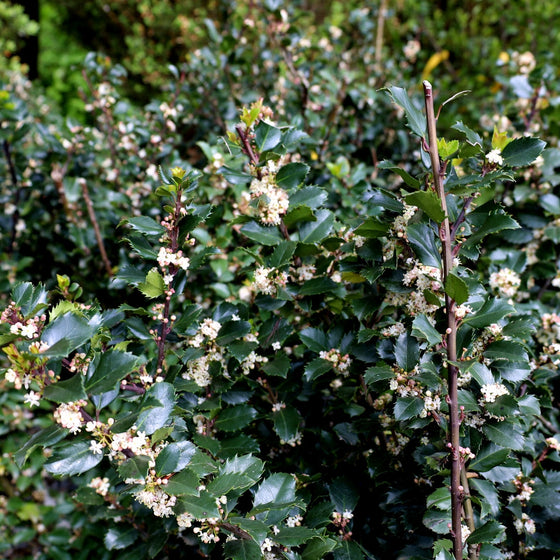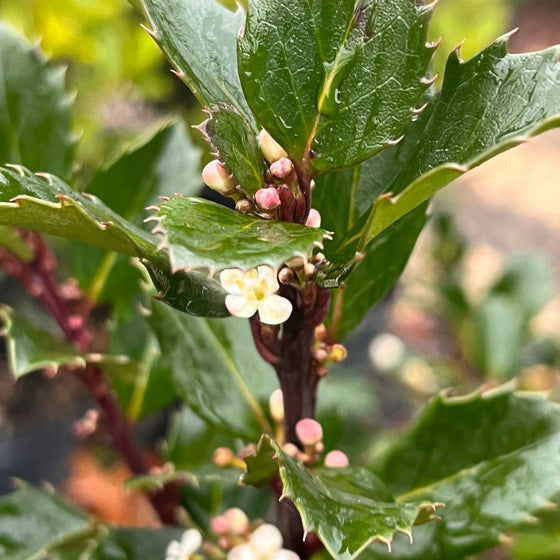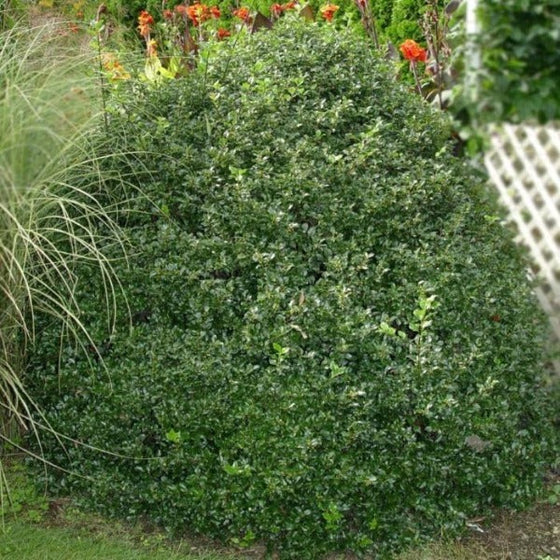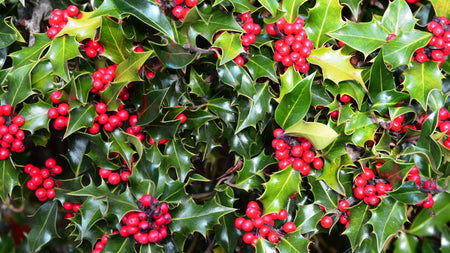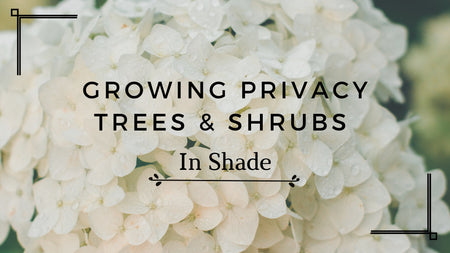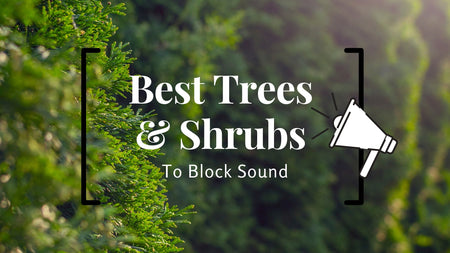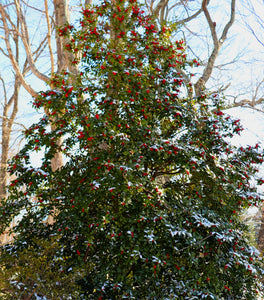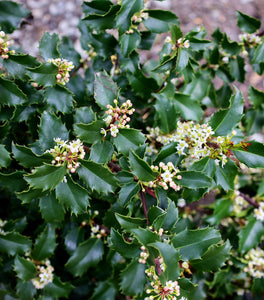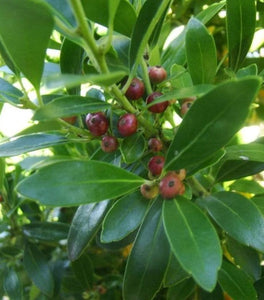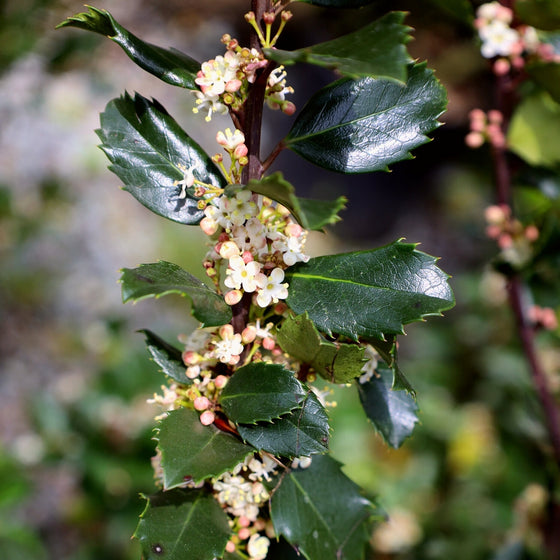
Images Depict Mature Plants
Blue Prince Holly for Sale Online
Blue Prince Holly (Ilex x meserveae 'Blue Prince') is a robust and evergreen male holly cultivar that is an essential pollinator for female hollies, such as Blue Princess, ensuring an abundance of striking red berries. Known for its dense, dark green foliage with a beautiful blue tint, Blue Prince adds year-round interest to any landscape. This shrub's shiny, serrated leaves are highly ornamental, providing a bold contrast to flowering plants and enhancing the beauty of garden borders or foundation plantings. Blue Prince Holly is also popular as a windbreak or hedge, offering privacy with its dense, upright growth habit, reaching 10 to 12 feet in height and 6 to 8 feet in width.
In addition to its value as a pollinator, Blue Prince Holly is highly tolerant of a variety of growing conditions. It performs well in both full sun and partial shade, making it adaptable to different locations in the garden. The shrub prefers moist, well-drained soil that is slightly acidic, but it can tolerate periods of drought once established. This versatility makes Blue Prince a low-maintenance addition to the garden, and it retains its glossy foliage throughout the year, even in colder climates. The cold-hardiness of Blue Prince makes it suitable for growing in USDA zones 5 to 8, and its evergreen nature ensures your garden has color and texture even during the winter months.
For optimal berry production on female hollies such as Blue Princess, China Girl, or Blue Maid, plant Blue Prince Holly within 30 to 50 feet of the female plants to facilitate effective pollination. Though Blue Prince does not produce berries, its dark blue-green leaves are an excellent foil for the bright red berries on the female shrubs. Its deer resistance also makes Blue Prince Holly a valuable addition to landscapes prone to deer browsing. Blue Prince Holly brings year-round color, structure, and ecological benefits to any garden, whether used as a pollinator, hedge, or striking accent plant.
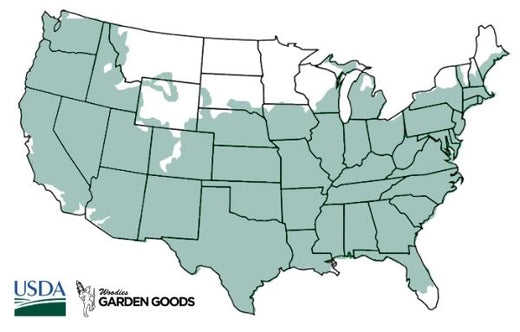
| Hardiness Zone: | 5-8 |
|---|---|
| Mature Height: | 8 to 10 Feet |
| Mature Width: | 4 to 6 Feet |
| Sunlight: | Full sun to part shade |
| Foliage Color: | Blueish-green, purple stems |
| Growth Form: | Upright |
| Soil: | Very tolerant of most soil conditions |
How to Care for Blue Prince Holly
Before you buy a Blue Prince holly, make sure to read about the recommended care instructions to keep this holly healthy and thriving.
How do I Plant Blue Prince Holly Shrubs?
To plant Blue Prince Holly shrubs, start by selecting a location with full sun to partial shade and well-drained, slightly acidic soil. Blue Prince Holly is adaptable, but it thrives in moist, fertile soils that offer good drainage. Begin by digging a hole that is twice as wide as the root ball and about the same depth. This gives the roots ample room to spread and establish. Place the shrub in the hole, ensuring that the top of the root ball is level with the surrounding soil. Gently backfill with the removed soil, firming it around the root ball to eliminate air pockets. Water the shrub thoroughly after planting to help it settle and ensure good root-to-soil contact. Once your Blue Prince Holly is planted, apply a 2-3 inch layer of organic mulch around the base of the shrub to retain soil moisture, moderate temperature, and prevent weed growth. Be sure to keep the mulch a few inches away from the trunk to avoid issues with rot. Space the shrubs 6 to 8 feet apart if planting multiple Blue Prince Hollies to create a hedge or screen. If planting as a pollinator for female hollies, ensure Blue Prince is within 30 to 50 feet of varieties like Blue Princess to guarantee successful pollination. Regular watering is crucial during the first growing season to help establish a strong root system, especially during dry periods. With proper planting and care, Blue Prince Holly will thrive, providing lush foliage and enhancing berry production on nearby female hollies.
How do I Water Blue Prince Holly Shrubs?
To water Blue Prince Holly shrubs, it is crucial to maintain consistent soil moisture, particularly during the first growing season when the plant is establishing its root system. Water deeply once or twice a week, depending on the weather and soil conditions, ensuring the moisture reaches the roots. Use a slow and thorough watering technique, such as a soaker hose, to allow the water to penetrate deeply rather than just wetting the surface. Blue Prince Holly prefers well-drained, slightly acidic soil, so avoid overwatering, which could lead to waterlogged conditions and root rot. Keeping the soil evenly moist but not soggy will help your holly grow strong and healthy, especially in the hotter months. Once your Blue Prince Holly is well-established, it will become more tolerant of drier conditions, though regular watering will still benefit the plant during prolonged dry spells. Always check the top 2-3 inches of soil; if it feels dry to the touch, it is time to water. Applying a 2-3 inch layer of mulch around the base of the shrub will help retain soil moisture and reduce evaporation, particularly in the summer heat. Be careful to keep the mulch away from the trunk to prevent fungal issues. Consistent watering, especially during dry periods, will keep Blue Prince Holly thriving, ensuring dense, attractive foliage that supports berry production on nearby female hollies like Blue Princess.
How do I Fertilize Blue Prince Holly Shrubs?
To fertilize Blue Prince Holly shrubs, start in early spring just before new growth appears. Use a balanced, slow-release fertilizer, such as a 10-10-10 or 12-6-6 formula, to provide the essential nutrients needed for healthy foliage and flower development. Spread the fertilizer evenly around the base of the shrub, extending it out to the drip line, which is the area under the outermost branches where the roots are most active in absorbing nutrients. Be careful not to let the fertilizer come into direct contact with the trunk to avoid damaging the roots. After applying, water the area thoroughly to help the nutrients penetrate the soil and reach the roots effectively. Blue Prince Holly also benefits from maintaining slightly acidic soil, so it’s helpful to test the soil pH before fertilizing. Ideally, holly shrubs prefer a pH between 5.0 and 6.5. If your soil is too alkaline, consider adding elemental sulfur to lower the pH and create more favorable conditions for the plant. You can also supplement with organic fertilizers, such as compost or well-aged manure, which help improve soil quality and provide slow-release nutrients over time. Avoid over-fertilizing, as this can lead to excessive leaf growth at the expense of flowering, which is crucial for pollinating nearby female hollies like Blue Princess. By properly fertilizing your Blue Prince Holly, you can maintain a healthy, vigorous plant that serves as an effective pollinator and adds year-round beauty to your garden.

How do I Prune Blue Prince Holly Shrubs?
To prune Blue Prince Holly shrubs, the best time is in late winter or early spring, just before new growth begins. This timing allows you to see the structure of the shrub more clearly and helps avoid removing the flower buds, which are essential for pollinating nearby female hollies like Blue Princess. Start by removing any dead, damaged, or diseased branches, cutting them back to the base to promote the overall health of the shrub. Thinning out crossing or crowded branches will also help improve airflow and light penetration, reducing the risk of fungal diseases and encouraging more vigorous growth. Use sharp, clean pruning shears to make precise cuts, ensuring that the plant stays well-shaped and healthy. Light pruning of Blue Prince Holly throughout the growing season can help maintain its natural, dense form, especially if you’re growing it as part of a hedge or foundation planting. However, avoid heavy pruning, as it may reduce the number of flowers, which are necessary for pollinating female holly shrubs and ensuring berry production. To maintain the shrub's size and shape, trim back any overly long branches, being careful not to remove more than one-third of the plant at a time. Pruning this way will help keep Blue Prince Holly healthy and attractive, allowing it to fulfill its role as a pollinator while also serving as a striking evergreen focal point in your garden.

